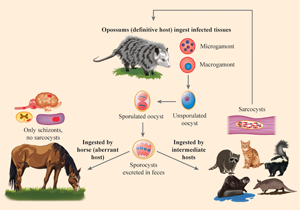Crossref Citations
This article has been cited by the following publications. This list is generated based on data provided by
Crossref.
Wieser, Sarah Nathaly
Decker-Franco, Cecilia
de Alba, Paloma
Romero, Sandra
Ferrari, Alejandro
Schnittger, Leonhard
and
Florin-Christensen, Mónica
2023.
Discovery of Antigens and Cellular Mechanisms in the Protozoan Parasite Sarcocystis aucheniae Using Immunoproteomics.
Parasitologia,
Vol. 3,
Issue. 4,
p.
349.
Gupta, Aditya
Duncan, Mary
Sweeny, Amy R.
de Araujo, Larissa S.
Kwok, Oliver C.H.
Rosenthal, Benjamin M.
Khan, Asis
Grigg, Michael E.
and
Dubey, Jitender P.
2023.
The same genotype of Sarcocystis neurona responsible for mass mortality in marine mammals induced a clinical outbreak in raccoons (Procyon lotor) 10 years later.
International Journal for Parasitology,
Vol. 53,
Issue. 14,
p.
777.
Shams, Farzane
Jokar, Mohammad
Abdous, Arman
Mohammadi, Pardis
Abbassioun, Aryan
Seuberlich, Torsten
and
Rahmanian, Vahid
2024.
Seroprevalence of Toxoplasma gondii and Neospora spp. in horse population of Tehran, Iran.
Scientific Reports,
Vol. 14,
Issue. 1,
Dubey, Jitender P.
Gupta, Aditya
Calero-Bernal, Rafael
de Araujo, Larissa S.
García-Gil, María L.
Battle, Jaquin
Ankarah, Ankrah
Van Why, Kyle
Brown, Justin D.
and
Rosenthal, Benjamin M.
2024.
Gray fox (Urocyon cinereoargenteus) identified as a new intermediate host for Sarcocystis neurona.
Veterinary Parasitology: Regional Studies and Reports,
Vol. 56,
Issue. ,
p.
101122.
Šneideris, Donatas
Moskaliova, Darija
Butkauskas, Dalius
and
Prakas, Petras
2024.
The Distribution of Sarcocsytis Species Described by Ungulates-Canids Life Cycle in Intestines of Small Predators of the Family Mustelidae.
Acta Parasitologica,
Vol. 69,
Issue. 1,
p.
747.
Elmahallawy, Ehab Kotb
Elbarbary, Nady Khairy
Cano-Terriza, David
Fajardo, Tomás
Albalawi, Nada Oudah
Jiménez-Martín, Débora
Ghallab, Marwa M. I.
Gareh, Ahmed
Ras, Refaat
Villena, Isabelle
Sadek, Sabry A. S.
AlQadeeb, Hajar
Alzaylaee, Hind
Almería, Sonia
and
García-Bocanegra, Ignacio
2025.
Toxoplasma gondii in dromedary camels (Camelus dromedarius) in Egypt: a comparative seroepidemiological study in Upper and Lower Egypt.
Frontiers in Veterinary Science,
Vol. 11,
Issue. ,
Jegatheesan, Annapoorani
Micciche, Margaret
Ngo, Jennifer
Bradley, Peter J.
Howe, Daniel K.
and
Dangoudoubiyam, Sriveny
2025.
Characterization of SnROP9, a rhoptry protein homologue of Sarcocystis neurona that is expressed in lifecycle stages lacking rhoptry organelles.
International Journal for Parasitology,
Valderrama‐Martinez, Claudia
Packham, Andrea
Zheng, Shichen
Smith, Woutrina
Plancarte, Magdalena
and
Aleman, Monica
2025.
Effect of refrigeration, room temperature, and processing time on serum immunofluorescent antibody titers for Sarcocystis neurona.
Journal of Veterinary Internal Medicine,
Vol. 39,
Issue. 1,
